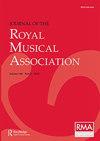Alienated Entertainment: Ludwig Berger’s Meistersinger Film Der Meister von Nürnberg (1927)
IF 0.5
2区 艺术学
0 MUSIC
引用次数: 0
Abstract
Abstract Der Meister von Nürnberg is a silent film adaptation of Wagner’s Die Meistersinger von Nürnberg remembered chiefly for the protests it generated on its release in 1927. Several authors refer to it briefly in reception histories of Die Meistersinger, but the film has not yet attracted sustained attention either within Wagner scholarship or within literature on opera and film. Der Meister von Nürnberg is, however, an effective lens through which to examine sensitivities in opera’s relationship with film in 1920s Germany, as well as various ambiguities in Weimar-era film making and consumption. The film constitutes fascinating proof of the historically conditioned reverence for Wagner’s Die Meistersinger that existed within conservative opera criticism in 1920s Germany, while its ephemerality serves as a key to understanding several wider features of the Weimar cultural landscape. In this sense, the film exceeds curiosity status and emerges as a multivalent artefact of a complex, contradiction-ridden time.《纳伦伯格大师》是由瓦格纳的《纳伦伯格大师》改编而成的无声电影,主要是因为1927年上映时引发的抗议。几位作者在《梅斯特尔歌手》的接受史中简要地提到了这部电影,但这部电影还没有引起瓦格纳学者或歌剧和电影文学的持续关注。然而,《伦伯格大师》是一个有效的镜头,通过它可以审视20世纪20年代德国歌剧与电影关系的敏感性,以及魏玛时代电影制作和消费的各种模糊性。这部电影引人入胜地证明了20世纪20年代德国保守歌剧批评中对瓦格纳的《大师歌者》(Die Meistersinger)的历史崇敬,而它的短暂性是理解魏玛文化景观的几个更广泛特征的关键。从这个意义上说,这部电影超越了好奇的地位,成为一个复杂、充满矛盾的时代的多重价值的人工制品。
本文章由计算机程序翻译,如有差异,请以英文原文为准。
求助全文
约1分钟内获得全文
求助全文
来源期刊
CiteScore
0.50
自引率
0.00%
发文量
16
期刊介绍:
The Journal of the Royal Musical Association was established in 1986 (replacing the Association"s Proceedings) and is now one of the major international refereed journals in its field. Its editorial policy is to publish outstanding articles in fields ranging from historical and critical musicology to theory and analysis, ethnomusicology, and popular music studies. The journal works to disseminate knowledge across the discipline and communicate specialist perspectives to a broad readership, while maintaining the highest scholarly standards.

 求助内容:
求助内容: 应助结果提醒方式:
应助结果提醒方式:


